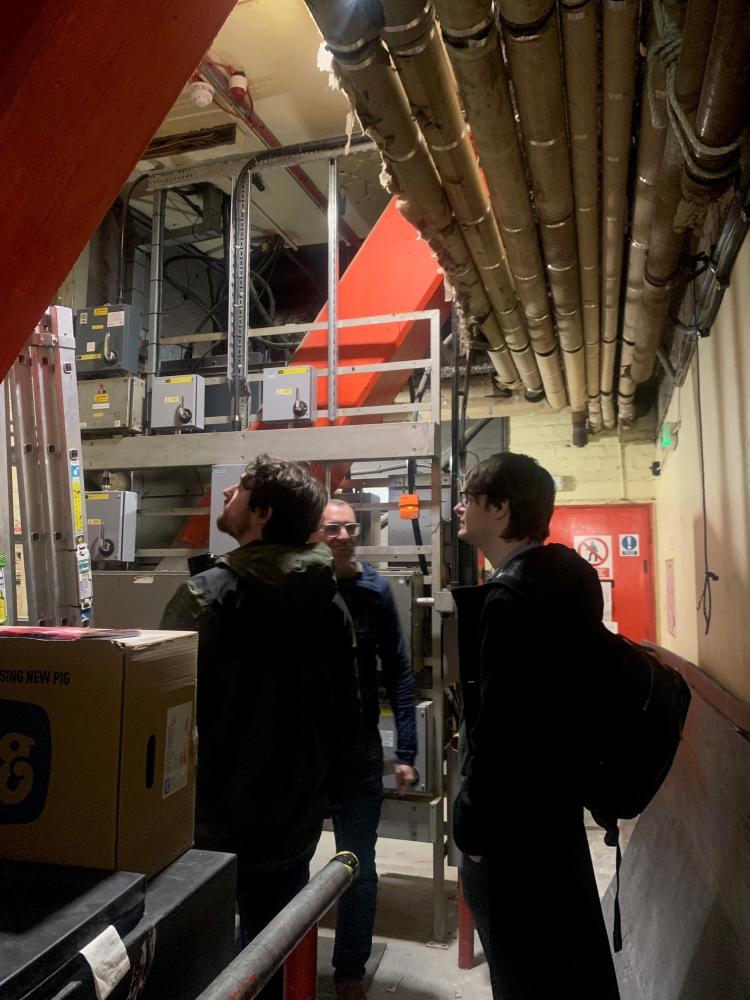Iconic archives at the British Film Institute puts the focus on a net zero world
We catch up with the people driving the net zero vision at the BFI and talk about its Low Carbon Skills Fund work
Every movie buff will be familiar with the iconic British Film Institute, home to one of the most famous collections in the world.
Founded in 1933, the BFI is a cultural charity, the Government’s lead body for film and the moving image, and a UK-wide National Lottery Distributor.
They have cinema venues in London, hold the National Film and Television Archive, and give out approximately £50 million of funding annually for the screen industries.
At Salix we’re privileged to support the BFI on taking bold steps for the future and support it with its net zero journey.

The Salix team visits the BFI and discover its vision for a net zero world
Photo credit: Salix Finance
This work is a small, but important part of safeguarding the BFI archives, buildings and vision for the future.
As the BFI transitions to a digital first organisation, it will embed net zero practices into all of its processes and the journey to net zero is at the forefront of its organisational strategy.
The organisation successfully bid for funding under the Public Sector Low Carbon Skills Fund, delivered by our teams at Salix.
The fund provides grants for public sector organisations to engage specialist and expert advice and skills needed to create heat decarbonisation plans to prepare for heat decarbonisation and energy efficiency works.
In 2024, the BFI was awarded £51,990 under Phase 5 of the fund, enabling it to commission a heat decarbonisation plan for four of their five sites.
We visited BFI Southbank to meet the people behind its net zero ambition and discuss how the fund will contribute to shaping the institute’s energy future.
Whilst crowds of people visit the BFI screens and archives every year – not many visitors get to look behind the scenes and see the areas that power the incredible facility.

The team pictured behind the scenes and discuss the digital technology at BFI
Photo credit: Salix Finance
Facing up to the challenges and talks of a heat network
We met Duncan Mckeich, head of facilities at the BFI, who explained the challenges the BFI faces when addresses climate change issues.
Our tour was focused on BFI Southbank and BFI IMAX but there are three other sites which benefited from the funding – BFI National Archive sites in Berkhamsted, Hertfordshire and Gaydon, Warwickshire, as well as the BFI head offices near Tottenham Court Road, London.
BFI Southbank is located directly under Waterloo Bridge and has no roof or external spaces to locate plant and equipment, which brings unique challenges around implementing energy efficiency measures.
Duncan said: “The challenges involve our lack of outdoor space for adopting technology like air source heat pumps and our distribution boards lack segregation required for us to isolate different systems such as lighting and general power.
“We also operate a public venue, so plant upgrade work requires complex sequencing to minimise disruption.
“BFI Southbank has evolved in stages from the mid 1950’s through to the present day and has lots of different systems and technologies for the different parts of the site and its operations. With the help of the heat decarbonisation plan we have a good idea of the areas we need to tackle along with the timescales and outline costs.
“We have already started our journey at BFI Southbank by making sure decarbonisation is at the forefront of decisions when replacing individual pieces of equipment.
“In early 2025 we will have decarbonised one of our cinema screens as we replace one of the air handlers and introduce heat pumps for this area.
“We are also working as a wider group along the South Bank area with neighbours and local interest groups to investigate the potential of an area wide heat network.”

The Low Carbon Skills Fund has allowed the BFI to create heat decarbonisation plans which will help it progress a more environmentally friendly future for its buildings
Photo credit: Salix Finance
As well as the work at Waterloo, the money from the Low Carbon Skills Fund will help plan a net zero future for the BFI National Archive and Conservation Centre in Berkhamsted, Hertfordshire.
The site has a number of large temperature and humidity controlled storage vaults of moving image, as well as, film, papers of individuals and organisations, stills, posters, costume and production designs, animation cels and promotional material, and many other unpublished items including scripts, storyboards and autographed letters.
Decarbonisation at this site will also be challenging as gas heat sources are used as part of the dehumidification process for these large storage vaults, but the BFI has already demonstrated it is possible to do when it replaced the systems for one of the vaults in 2024 and used heat pumps instead of natural gas.
Master Film Store in Gaydon
The BFI stores its most important collections at the Master Film Store in Gaydon, Warwickshire. This is a word class film storage facility designed to preserve valuable film archives including storage of flammable Nitrate film at -5°C and 35% relative humidity.
BFI Gaydon already accommodates solar PV arrays, but the heat decarbonisation plan has identified further opportunities for the replacement of chillers and installation of heat pumps to remove liquid petroleum gas sources from the site.
Duncan says he is confident the heat decarbonisation plan will help it plot capital works for a more sustainable future by giving the BFI a timescale and idea of cost to allow it to incorporate this into its business planning process and educate the wider BFI on what we need to do.
Sustainability journey
During the visit our Salix programme manager Charles Pegg said he was impressed by the thinking behind the way the BFI was forging ahead with its vision for a carbon free future.
He said: “As a lover of film myself, it’s inspiring to see how the vision has been plotted and communicated across the BFI. It has big ambitions and because its buildings are housing such unique and precious objects, any work needs to be carefully thought out.
“The BFI is home to such a rich and important part of our cultural history and its especially inspiring to hear how they plan to share the lessons they learn with other cultural bodies”
As a lover of film myself, it’s inspiring to see how the vision has been plotted and communicated across the BFI. It has big ambitions and because its buildings are housing such unique and precious objects, any work needs to be carefully thought out.
The BFI sustainability journey started years ago but decarbonising is the most challenging element of the work so far.
It first installed heat pumps as part of the construction of BFI IMAX when it opened in 1999 and all the heating and cooling across the entire site is provided by four ducted reservable air to water source heat pumps, which have proved the technology to the BFI, making adoption at other sites easier.
Duncan added: “It is imperative that we commit to a step change in how we work as an organisation.
“In 2025, we will utilise our existing heat decarbonisation plan and commission a route map to net zero including a full baseline of our scope 3 emissions to reach net zero ahead of the 2050 government deadline.
“This route map will help us determine how we embed sustainability into estate upgrades and operational planning. We will prioritise those areas of greatest impact, and find the most sustainable option for the future of the National Archive.
“As we transition to being a digital-first organisation, it will help us embed low-carbon practices throughout our decision-making.”



